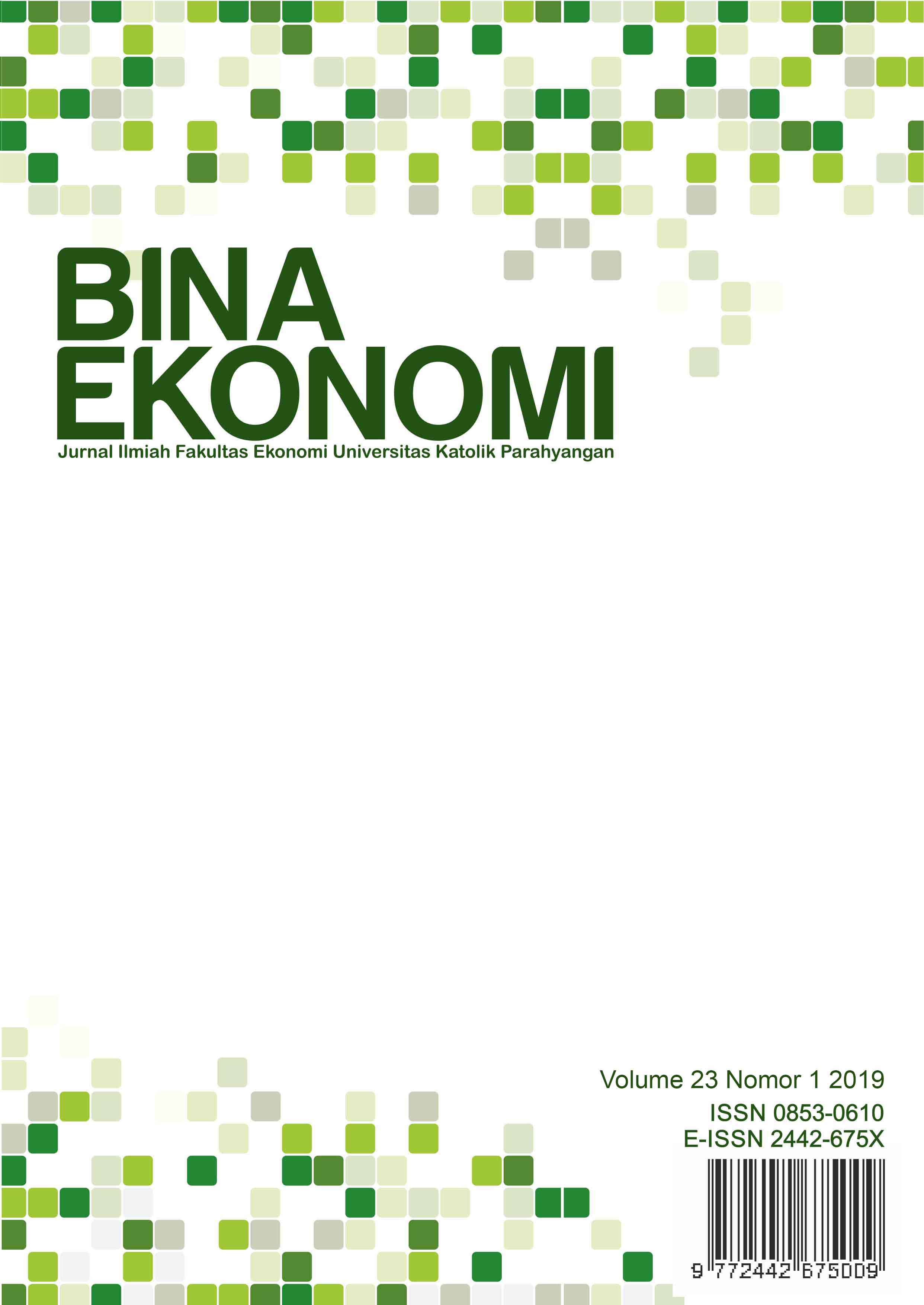DAMPAK PENGELUARAN PEMERINTAH TERHADAP PERTUMBUHAN EKONOMI: STUDI KASUS PANEL DATA
DOI:
https://doi.org/10.26593/be.v23i1.3872.13-28Abstract
ABSTRACT
The relationship between government expenditures and economic growth is an ambiguous relationship. The results of previous empirical studies indicate that the relationship between the two variables can be a positive or negative relationship. The purpose of this study is to investigate a more detailed relationship between economic growth and government expenditures. The detailed information between these two variables is obtained by investigating the direction of the relations in three levels, i.e. in various countries, in Indonesia, and in provinces in Indonesia. Furthermore, this research also investigates the variables which can drive the economic growth in those three groups of estimations. This research is conducted by using fixed effects panel data method for 96 countries and 33 provinces in Indonesia. The countries’ data are estimated for the period of 1991–2014, while the provinces in Indonesia data are estimated for the period 2011–2013. Based on the results, it can be concluded that the relationship between government expenditures and economic growth depends on many factors. Moreover, the results also show variations in the relations between the two observed variables in the three groups of estimations.
Keywords: economic growth; government expenditures; panel data; fixed effects model
References
Alshahrani, S. A., & Alsadiq, A. J. (2014). Economic growth and government spending in Saudi Arabia: An empirical investigation. IMF Workong Paper WP/14/3.
Arpaia, A., & Turrini, A. (2008). Government expenditure and economic growth in the EU: Long-run tendencies and short-term adjustment. Economic Papers 300, European Economy.
Barro, R. J. (1989). The neoclassical approach to fiscal policy. 178-235. Cambridge, MA: Harvard University Press.
Barro, R. J. (1990). Government spending in a simple model of endogenous growth. Journal of Political Economy, 98(5), 103-125.
Barro, R. J. (1991).Economic growth in a crossection of countries. Quartely Journal of Economy, 106, 407-444.
Devarajan, S., & Vinaya, S. (1993) What do government buy? The composition of public spending and economic performance. Policy Research Working Paper, The World Bank, WPS 1082
Diamond, J. (1989). Government expenditure and economic growth: An empirical investigation. IMF Working Paper N0 84/85, Washington DC.
Folster, S., & Henrekson, M. (1999). Growth and public sector: A critique of the critics. European Journal of Political Economy, 15(2), 337-358.
Ghali, K. H. (1997). Government spending and economic growth in Saudi Arabia. Journal of Economic Development, 22(2), 165-172.
Grossman, P. J. (1988). Government and Economic Growth. A non-linear Relationship. Public Choice, Vol. 56, 193-200.
Gujarati, D. N. (2003). Basic Econometrics (4th ed.). New York: McGraw-Hill.
Gujarati, D. N., & Porter, D. C. (2009). Basic Econometrics (5th ed.). New York: McGraw-Hill.
Joharji, G. A., & Starr, M. (2011). Fiscal policy and growth in Saudi Arabia. Review of Midle East Economics and Finance, 6(3), 24-45. doi:10.2202/1475-3693.1305
Kweka, J. P., & Morrissey, O. (2000). Government spending and economic growth in Tanzania, 1965-1996 (No. 00/6). CREDIT Research Paper.
Kompas, T. (2000). Private incentives, government size and economic growth in Indonesia. Gadjah Mada International Journal of Business, 2(2000).
Landau, D. (1983). Government expenditure and economic growth: A cross country evidence. Southern Economic Journal, 49, 783-792.
Lin, S.A.Y. (1994). Government spending and economic growth. Applied Economic, 26, 83-94.
Loizides, J., & Vamvoukas, G. (2005). Government expenditure and economic growth: Evidence from trivariate causality testing. Journal of Applied Economics,. 8(1), 125-152.
Mangkoesoebroto, G. (1999). Ekonomi Publik. Yogyakarta: Balai Penerbit Fakultas Ekonomi (BPFE) UGM.
Nerlove, M. (2000). An essay history of panel data econometrics. Ninth International Conference of Panel Data in Genewa, Swiss.
Bose, N., Haque, M. E., & Osborn, D. R. (2007). Public expenditure and economic growth: A disaggregated analysis for developing countries. The Manchester School, 75(5), 533-556. doi:10.1111/j.1467-9957.2007.01028.x
Ram, R. (1986). Government size and economic growth: A new framework and some evidence from cross-sectional and time-series data. American Economics Review, 76, 191-203.
Ramayadi, A. (2003). Economic Growth and Government Size in Indonesia: Some Lesson for the Local Authorities. Working Paper in Economics and Development Studies 20032. Department of Economics, Universitas Padjadjaran.
Romer, P. M. (1990). Endogenous technological change. Journal of Political Economy, 98(5, Part 2), 71-102.
Sodik, J. (2007). Pengeluaran pemerintah dan pertumbuhan ekonomi regional: Studi kasus data panel di Indonesia. Jurnal Ekonomi Pembangunan Kajian Ekonomi Negara Berkembang, 12(1), 27-36.


